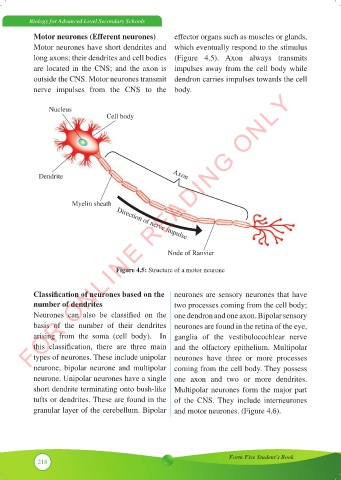Page 225 - Biology_F5
P. 225
Biology for Advanced Level Secondary Schools
Motor neurones (Efferent neurones) effector organs such as muscles or glands,
Motor neurones have short dendrites and which eventually respond to the stimulus
long axons; their dendrites and cell bodies (Figure 4.5). Axon always transmits
are located in the CNS; and the axon is impulses away from the cell body while
outside the CNS. Motor neurones transmit dendron carries impulses towards the cell
nerve impulses from the CNS to the body.
FOR ONLINE READING ONLY
Nucleus
Cell body
Dendrite Axon
Myelin sheath Direction of nerve impulse
Node of Ranvier
Figure 4.5: Structure of a motor neurone
Classification of neurones based on the neurones are sensory neurones that have
number of dendrites two processes coming from the cell body;
Neurones can also be classified on the one dendron and one axon. Bipolar sensory
basis of the number of their dendrites neurones are found in the retina of the eye,
arising from the soma (cell body). In ganglia of the vestibulocochlear nerve
this classification, there are three main and the olfactory epithelium. Multipolar
types of neurones. These include unipolar neurones have three or more processes
neurone, bipolar neurone and multipolar coming from the cell body. They possess
neurone. Unipolar neurones have a single one axon and two or more dendrites.
short dendrite terminating onto bush-like Multipolar neurones form the major part
tufts or dendrites. These are found in the of the CNS. They include interneurones
granular layer of the cerebellum. Bipolar and motor neurones. (Figure 4.6).
Form Five Student’s Book
218

